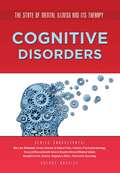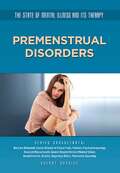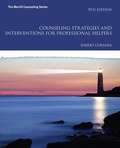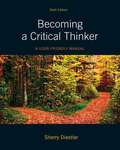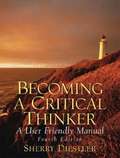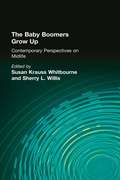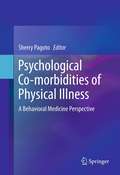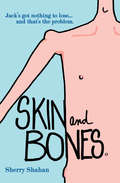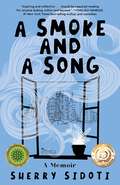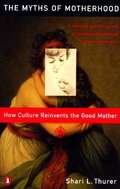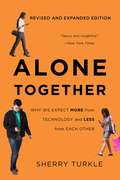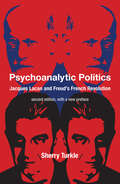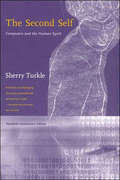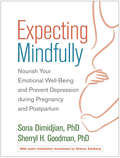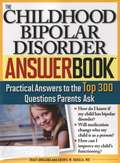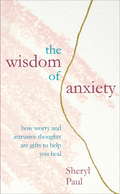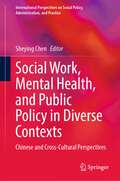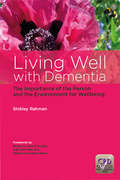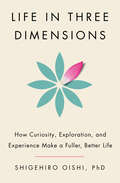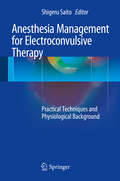- Table View
- List View
Cognitive Disorders (The State of Mental Illness and Its Ther #19)
by Sherry BonniceImagine what it would be like to look at the faces of your family members and friends and not know who they are. How would it feel to wake up each morning and find that another piece of your mind had slipped away? What would you do if you could not remember the simplest things, like whether you should get out of bed in the mornings or how to brush your hair? Cognitive disorders like Alzheimer's disease and other forms of dementia are devastating, not only to the individuals who suffer from them, but to those individuals' families and friends as well. These disorders have become serious topics of research and discussion. Helping patients, caretakers, families, and friends understand what can be done to ease the symptoms of cognitive disorders is a very important part of care. In this book, you will learn about cognitive disorders, what it is like to have them, and how they can be treated. Along the way, you will read about drugs that can help with symptoms like depression, panic, and hallucinations, all of which can be caused by cognitive disorders. In addition, you will learn about some alternative treatments for cognitive disorders and the possible risks and side effects that accompany different forms of treatment. Coauthored by someone who has experience first-hand the early stages of Alzheimer's, this book will give you an up-close view of what can be done to help individuals with these often-devastating forms of mental illness.
Premenstrual Disorders (The State of Mental Illness and Its Ther #19)
by Sherry BonnicePremenstrual syndrome plays a very real role in the lives of adolescent girls and women who suffer from its symptoms. Although this disorder has been misunderstood, undertreated, and disregarded as merely "all in her head," research confirms that PMS is a problem that can cause women to suffer poor relationships, lower academic grades, and physical and mental disturbances. Furthermore, doctors now understand that premenstrual disorders are legitimate medical conditions with real and serious implications for women's mental well-being. In this book you can learn about premenstrual disorders, how they have been unfairly stigmatized, and how they are finally being understood. With new medical understanding has come new treatments. Learn about antidepressants and other medications currently being used to treat serious symptoms of premenstrual disorders. In addition, you can learn about the benefits, risks, and side effects associated with these drugs as well as alternative treatments for premenstrual disorders. While you read, you will share in the experiences of many women from high school to perimenopausal age who have struggled with premenstrual disorders and their effects. In their stories, you will see that due to new understanding and treatments, women experiencing premenstrual disorders no longer need to feel stigmatized or alone.
Counseling Strategies and Interventions for Professional Helpers
by Sherry CormierThis pragmatic text describes basic helping skills used in a variety of disciplines, as well as a number of issues common to helping relationships, processes, and interviews. Suitable for both upper level undergraduate and entry level graduate students, the text focuses on skill acquisition, and includes a number of clinical cases and application exercises for promoting skill development.
Becoming A Critical Thinker: A User-friendly Manual
by Sherry DiestlerThis is the eBook of the printed book and may not include any media, website access codes, or print supplements that may come packaged with the bound book. Developing Instinctive Analytical Skills in Students Becoming a Critical Thinker: A User Friendly Manual trains students to distinguish high-quality, well-supported arguments from those with little or no evidence to support them. It develops the skills required to effectively evaluate the many claims facing them as citizens, learners, consumers, and human beings, and also to be effective advocates for their beliefs. Teaching and Learning Experience Personalize Learning - MyThinkingLabdelivers proven results in helping students succeed, provides engaging experiences that personalize learning, and comes from a trusted partner with educational expertise and a deep commitment to helping students and instructors achieve their goals. Improve Critical Thinking - Coverage of persuasive speaking, decision-making, the Toulmin model of argumentation, and chapter-end writing and speaking exercisesall teach students to construct and present arguments so that they can gain skill and confidence. Engage Students - Becoming a Critical Thinker: A User Friendly Manual exposes students to a variety of contemporary and multicultural issues, engaging their understanding of analytical skills through the use of articles and varied examples. Support Instructors - Teaching your course just got easier! You can create a Customized Text or use our Instructor’s Manual, Electronic “MyTest” Test Bank or PowerPoint Presentation Slides. PLUS, our new Instructor’s Manual has been updated and expanded with revised tests and answer keys, a discussion of chapter exercises, and suggestions for teaching critical thinking concepts.
Becoming a Critical Thinker
by Sherry DiestlerThis book can help you develop the skills needed to effectively make the many decisions facing you as a citizen, learner, consumer, and human being, and also to be an effective advocate for your beliefs.
The Baby Boomers Grow Up: Contemporary Perspectives on Midlife
by Susan Krauss Whitbourne Sherry L. WillisThe goal of this volume is to examine development in middle age from the perspective of baby boomers -- a unique cohort in the United States defined as those individuals born from 1946 to 1962. This is the largest cohort ever to enter middle age in Western society, and they currently represent approximately one-third of the total U.S. population. The Baby Boomers Grow Up provides contemporary and comprehensive perspectives of development of the baby boomer cohort as they proceed through midlife. Baby boomers continue to exert a powerful impact on the media, fiction, movies, and even popular music, just as they were an imposing force in society from the time of their entry into youth. As these individuals enter the years normally considered to represent midlife, they are redefining how we as a society regard adults in their middle and later years. This volume features several unique aspects. First, the literature reviewed focuses specifically on research relevant to baby boomers and their development as adults, rather than a global perspective on middle age. Second, the volume takes into account the diversity within the boomer cohort, such as social class, race, and education. In addition, quantitative and qualitative developmental changes occurring from the forties to the fifties and the sixties are considered. Differences in leading and trailing edge boomers are likewise addressed. Ideal for researchers in adult development and graduate seminars on adult development, The Baby Boomers Grow Up will also appeal to adult educators, human resource personnel, health professionals and service providers, and clinical psychologists and counselors.
Psychological Co-morbidities of Physical Illness
by Sherry PagotoEvidence for the efficacy of behavioral approaches to the treatment and management of physical illness is mounting, as is the evidence for behavioral interventions for psychological disorders. A pressing question that remains is how to effectively treat co-morbid physical and psychological illnesses. Diseases co-occur more often than not, and the co-occurrence of physical and psychological illnesses is associated with greater impairment and healthcare costs. Unfortunately, the treatment literature has traditionally been disease-specific, with fewer insights and discoveries regarding the underlying processes of co-morbid physical and psychological illnesses, and even fewer of approaches to treatment. Research on co-morbidities between physical and psychological illnesses has focused primarily on depression. Quite extensive literatures describe the negative impact of depression on type 2 diabetes, cardiovascular disease, cancer, obesity, pain, and other physical illnesses. More recently, higher rates of physical illness have been documented in individuals with bipolar disorder, anxiety disorders, schizophrenia, and impulse control disorders. Studies emanating from the National Comorbidity Survey-Replication (NCS-R), the only U.S. population-based database that includes diagnostic information on all DSM-IV psychological disorders, have revealed strong links between a number of physical and psychological illnesses. These data draw attention to the prevalence of physical and psychological co-morbidities at the population level, which has stimulated research on the biobehavioral mechanisms of those co-morbidities, with the goal of developing and improving treatment approaches. As this area of research grows, practical resources are needed for clinicians and researchers who encounter individuals with co-morbid physical and psychological illnesses in their work. This book is the first to provide a comprehensive overview of psychological co-morbidities of physical illness, biological and behavioral mechanisms of those co-morbidities, and implications for treatment. Each chapter focuses on a physical condition, such as obesity, type 2 diabetes, HIV infection, tobacco dependence, cardiovascular disease, cancer, asthma, pain, irritable bowel syndrome, autoimmune disorders, and obstetric/gynecological conditions. Chapters are structured to cover 1) the epidemiology of the most prevalent co-morbid psychological disorders within that physical condition (e.g., depression and other mood disorders, anxiety disorders, psychotic disorders, impulse control disorders, and eating disorders; 2) biobehavioral mechanisms of the co-morbidity; 3) a review of the behavioral treatment literature including evidence-based practice guidelines (where available); and 4) treatment considerations including issues of stepped care, evidence-based treatment decisions, treatment sequencing, treatment blending, treatment interactions, and contraindications. Content is guided by available research evidence and relevant theoretical models, and it is presented in such a way as to inform clinical practice, identify important gaps in the research literature, and provide directions for future research. The book serves as a tool for clinicians and researchers who work in the area of behavioral medicine in medical, academic, and/or training settings. Patients with psychological and medical co-morbidities may be encountered by clinicians working in either mental health or medical settings, where the presenting problem could be either the psychological disorder or the medical disorder. As such, assessment and treatment issues are discussed from both perspectives. For the clinician, the book reviews brief assessment tools, provides practical summaries of the treatment outcome literature and treatment considerations (e.g., treatment sequencing, contraindications), and includes treatment decision hierarchies that help the clinician incorporate each facet of evidence-based decisions (the evidence, patient characteristics, and their own expertise). For the researcher, the b...
Number Talks, Grades K-5: Helping Children Build Mental Math and Computation Strategies
by Sherry ParrishNumber Talks A five- to fifteen-minute classroom conversation around purposefully crafted computation problems that are solved mentally. The best part of a teacher's day. This dynamic multimedia resource was created in response to the requests of teachers--those who want to implement number talks but are unsure of how to begin and those with experience who want more guidance in crafting purposeful problems. It supports teachers in understanding: what a classroom talk is; how to follow students' thinking and pose the right questions to build understanding; how to prepare for and design purposeful number talks; and how to develop grade-level-specific strategies for the operations of addition, subtraction, multiplication, and division. Number Talks supports the Common Core State Standards for Mathematics.
Skin and Bones
by Sherry ShahanSixteen-year-old Jack, nicknamed "Bones," won't eat. His roommate in the eating disorder ward has the opposite problem and proudly goes by the nickname "Lard." They become friends despite Bones's initial reluctance. When Bones meets Alice, a dangerously thin dancer who loves to break the rules, he lets his guard down even more. Soon Bones is so obsessed with Alice that he's willing to risk everything--even his recovery.
A Smoke and a Song: A Memoir
by Sherry SidotiJanuary 2021, ten months into the global pandemic, Sherry Sidoti’s mother is diagnosed with terminal cancer—so Sherry prioritizes a trip to Manhattan over long-awaited empty-nesting and her “second chance” with fiancé Jevon. With new life blooming and loss looming, she is beckoned to answer the question that has haunted her since childhood: is freedom found in “letting go,” as the spiritual teachers (and her mother) insist—or is it found by digging our heels deeper into the earth and holding on to our humanness?A Smoke and a Song is Sherry’s story of her quest to make meaning from the memories homed in her body. Told with tenacity, tenderness, and wry humor, Sherry stumbles towards self-actualization, spiritual awakening—and, despite it all, love. This is a story steeped in art and spirituality that explores the complexities of transgenerational maternal bonds, attachment, loss, and leaning in to our wounds to find the wisdom.
Myths Of Motherhood: How Culture Reinvents the Good Mother
by Sherry ThurerThis groundbreaking and irreverent history of motherhood is worth a hundred advice books for any mother who’s ever been made to feel guilty or frazzled by society’s impossible expectations. Analyzing data from the psychoanalyst’s couch to the hidden history of wet nursing, psychologist Shari L. Thurer wends her way from the Stone Age to the age of Hillary Rodham Clinton, painting a vivid, often frightening picture of life for mothers and children in a time when their roles were constructed by men. Along the way, she debunks myth after myth—exposing the not-so-golden ages of Classical Greece and the Italian Renaissance, and revealing the pervasive ideal of Dr. Spock’s selfless, stay-at-home mother as the historical aberration it actually was. A work of impassioned scholarship and astonishing range, The Myths of Motherhood does nothing less than recast our conception of good mothering.
Alone Together: Why We Expect More from Technology and Less from Each Other
by Sherry TurkleConsider Facebook—it’s human contact, only easier to engage with and easier to avoid. Developing technology promises closeness. Sometimes it delivers, but much of our modern life leaves us less connected with people and more connected to simulations of them.In Alone Together, MIT technology and society professor Sherry Turkle explores the power of our new tools and toys to dramatically alter our social lives. It’s a nuanced exploration of what we are looking for—and sacrificing—in a world of electronic companions and social networking tools, and an argument that, despite the hand-waving of today’s self-described prophets of the future, it will be the next generation who will chart the path between isolation and connectivity.
Alone Together: Why We Expect More from Technology and Less from Each Other
by Sherry TurkleConsider Facebook--it's human contact, only easier to engage with and easier to avoid. Developing technology promises closeness. Sometimes it delivers, but much of our modern life leaves us less connected with people and more connected to simulations of them. In Alone Together, MIT technology and society professor Sherry Turkle explores the power of our new tools and toys to dramatically alter our social lives. It's a nuanced exploration of what we are looking for--and sacrificing--in a world of electronic companions and social networking tools, and an argument that, despite the hand-waving of today's self-described prophets of the future, it will be the next generation who will chart the path between isolation and connectivity.
Psychoanalytic Politics, second edition, with a new preface: Jacques Lacan and Freud's French Revolution
by Sherry TurkleAn updated edition of the seminal book that explores why the interest in psychoanalysis in France exploded after 1968 and what it says about culture and therapy.Among Western countries, France may well be the one that resisted Freud the longest. But, in the late 1960s, France was seized by an infatuation with Freudianism. By the end of that decade, France had more than a psychoanalytic movement: it had a widespread and deeply rooted psychoanalytic culture. At the heart of this development was Jacques Lacan's reconstruction of Freudian theory, a reinvention of psychoanalysis that resonated with French culture in the aftermath of the uprisings of 1968. In Psychoanalytic Politics, the second edition of her groundbreaking work, Sherry Turkle tells the fascinating story of Lacan and why his work so profoundly influenced the French psyche. While in the United States psychoanalysis is identified with an essentially conservative medical establishment, the French rediscovery of Freud, in a dramatic enactment of Freud&’s prophesy, became associated with the most radical elements of French philosophical and political life. In this book, Turkle provides a firsthand account of the psychoanalytic culture that developed in France—as a politicized, Gallicized, and poeticized Freudianism, deeply marked by the work of Jacques Lacan. The clearest introduction in English to Lacan's teaching, Psychoanalytic Politics explores how cultures appropriate theories of mind and how ideas come to connect with individuals. The book&’s final chapter provides a fascinating portrayal of the last years of Lacan&’s life—the intrigue and power struggles that resulted in the break-up of the Freudian School he founded and the events that unfolded in the years following his death in 1981.This edition includes a new preface by the author, reflecting on the origins of the book and its relevance for today: a time when the integration of thought and feeling, politics and self-examination is as urgent an endeavor as ever.
Simulation and Its Discontents
by Sherry TurkleOver the past twenty years, the technologies of simulation and visualization have changed our ways of looking at the world. In Simulation and Its Discontents,Sherry Turkle examines the now dominant medium of our working lives and finds that simulation has become its own sensibility. We hear it in Turkle's description of architecture students who no longer design with a pencil, of science and engineering students who admit that computer models seem more "real" than experiments in physical laboratories. Echoing architect Louis Kahn's famous question, "What does a brick want?", Turkle asks, "What does simulation want?" Simulations want, even demand, immersion, and the benefits are clear. Architects create buildings unimaginable before virtual design; scientists determine the structure of molecules by manipulating them in virtual space; physicians practice anatomy on digitized humans. But immersed in simulation, we are vulnerable. There are losses as well as gains. Older scientists describe a younger generation as "drunk with code." Young scientists, engineers, and designers, full citizens of the virtual, scramble to capture their mentors' tacit knowledge of buildings and bodies. From both sides of a generational divide, there is anxiety that in simulation, something important is slipping away. Turkle's examination of simulation over the past twenty years is followed by four in-depth investigations of contemporary simulation culture: space exploration, oceanography, architecture, and biology. Simplicity: Design, Technology, Business, Life, edited by John Maeda
The Second Self, Twentieth Anniversary Edition: Computers and the Human Spirit (The\mit Press Ser.)
by Sherry TurkleA new edition of the classic primer in the psychology of computation, with a new introduction, a new epilogue, and extensive notes added to the original text.In The Second Self, Sherry Turkle looks at the computer not as a "tool," but as part of our social and psychological lives; she looks beyond how we use computer games and spreadsheets to explore how the computer affects our awareness of ourselves, of one another, and of our relationship with the world. "Technology," she writes, "catalyzes changes not only in what we do but in how we think." First published in 1984, The Second Self is still essential reading as a primer in the psychology of computation. This twentieth anniversary edition allows us to reconsider two decades of computer culture—to (re)experience what was and is most novel in our new media culture and to view our own contemporary relationship with technology with fresh eyes. Turkle frames this classic work with a new introduction, a new epilogue, and extensive notes added to the original text.Turkle talks to children, college students, engineers, AI scientists, hackers, and personal computer owners—people confronting machines that seem to think and at the same time suggest a new way for us to think—about human thought, emotion, memory, and understanding. Her interviews reveal that we experience computers as being on the border between inanimate and animate, as both an extension of the self and part of the external world. Their special place betwixt and between traditional categories is part of what makes them compelling and evocative. (In the introduction to this edition, Turkle quotes a PDA user as saying, "When my Palm crashed, it was like a death. I thought I had lost my mind.") Why we think of the workings of a machine in psychological terms—how this happens, and what it means for all of us—is the ever more timely subject of The Second Self.
Expecting Mindfully: Nourish Your Emotional Well-Being and Prevent Depression during Pregnancy and Postpartum
by Sona Dimidjian Sherryl H. GoodmanUnlike other mindfulness resources for moms and moms-to-be, this compassionate book is grounded in mindfulness-based cognitive therapy, a proven program. The authors are leading experts on the emotional challenges of pregnancy and early parenting--and how to overcome them. Guided meditations and gentle yoga practices help you build crucial skills to prevent depression, ease anxiety, and minimize stress during this unique and important phase of your life. Clear suggestions for how to follow the program day by day are accompanied by moving reflections from a "circle of mothers" working through the same steps. In a convenient large-size format, the book features journaling exercises and other practical tools (you can download and print additional copies as needed). The companion website also includes audio downloads narrated by renowned meditation teacher Sharon Salzberg, plus video clips of prenatal yoga practices.
The Childhood Bipolar Disorder Answer Book: Practical Answers to the Top 300 Questions Parents Ask
by Tracy Anglada Sheryl HakalaHow does bipolar disorder affect learning? Is there a cure? Is this a fad diagnosis? How do I handle manipulation? How can I prevent relapses? Should I use alternative treatments? How can I parent effectively? "We are certain that all parents whose children struggle with bipolar disorder will find this book indispensable." - Demitri F. Papolos, MD, and Janice Papolos, authors of The Bipolar Child. Co-written by a doctor and a mother whose children live with bipolar disorder, The Childhood Bipolar Disorder Answer Book explains confusing medical lingo and provides straightforward answers to all your pressing questions about treatment, parenting strategies, and everything else. How is childhood bipolar disorder different from an adult onset? What are the earliest symptoms? Why is my child so irritable? How young can these symptoms manifest? Should all family members be evaluated for bipolar disorder? Will my child lead a normal life? Written in an easy-to-read Q&A format, The Childhood Bipolar Disorder Answer Book helps you understand and accept your child and develop a plan for success.
Through the Looking Glass: Observations in the Early Childhood Classroom
by Sheryl Nicolson Susan G. ShipsteadTaking a strong developmental focus, this book ensures that teachers understand the close relationship between observing, understanding what has been observed, and improving the educational curriculum and environment. This edition is the result of a continued commitment to produce a book on observation that unites solid methodological instruction with a broad understanding of children's development. Chapter 1 now covers information on professional development such as the reader's responsibilities and an introduction to professional organizations, developmentally appropriate practice, and ethical conduct in early childhood education. A new Chapter 2 details the practical issues of finding the time to observe, learning the basics of observation, and minimizing subjectivity. Highlights of development during preschool and primary grades serve as a common ground of information for both novice and knowledgeable readers to respond sensitively to children's individualities and cultures. Each chapter incorporates an ethic from the National Association for the Education of Young Children's (NAEYC) "Code of Ethical Conduct" --and presents a concrete application to connect daily work with professional values For early childhood educators.
The Wisdom of Anxiety: How worry and intrusive thoughts are gifts to help you heal
by Sheryl Paul'We have to shift from a mindset of shame, which sees anxiety as evidence of brokenness, to a mindset of curiosity, which recognizes that anxiety is evidence of our sensitive heart, our imaginative mind and our soul's desire to grow towards wholeness.' Three million people are thought to suffer from anxiety in the UK, and it is an issue that affects a growing number of people across all ages. For anyone troubled by obsessive thoughts, insomnia and other manifestations of anxiety, counsellor Sheryl Paul offers shelter in the storm. In The Wisdom of Anxiety, Paul reveals that anxiety, like any emotion, is a signal - a clear bodily invitation to heal and renew your trust in your choices, self-image and core values. Weaving together practical exercises with personal stories, Paul offers medication-free approaches for accessing the gifts in different kinds of anxiety, and especially the anxiety summoned by life's transitions, for example a career change, becoming parents or becoming carers for loved ones. Chapters include recognising the symptoms of anxiety, its origins, the myth of 'normal', the expectation of happiness and a timeline of healing that includes exercises for the body and mind. There are also chapters on parenting in an age of anxiety and the vulnerability of connection and relationships.
Social Work, Mental Health, and Public Policy in Diverse Contexts: Chinese and Cross-Cultural Perspectives (International Perspectives on Social Policy, Administration, and Practice)
by Sheying ChenThe discipline of social policy, oftentimes deemed a part of social work as a profession, was born in the West. Unlike social policy that started with the post-war idea of a welfare state in the mid-20th century, social work traces its roots to individual casework pioneered by the Charity Organization Society (COS), early social administration including state-wide poverty relief (an advocacy effort of the COS but with deep roots in the English Poor Laws of the 17th century), and social action emphasizing political activities to improve social conditions (originating from the Settlement House Movement which began in the 1880s).The development of social work is historically intertwined with that of public welfare, philanthropy, and charity and is an inherently international subject. This conception is broader than “international social work” as a discrete field of professional practice, which crosses geopolitical borders and all levels of social and economic organizations with a focus on development. However, each nation has a story of its own in terms of professionalization of social work in the evolution of public welfare and philanthropic/charitable undertaking within its particular economic, political, social, and cultural settings. A wide-ranging and in-depth study of various (especially non-Western) country cases is essential to an adequate, comprehensive understanding of the social work profession, which is also a basic requirement of its value of diversity.China is undoubtedly an important case with the largest population on earth. It’s also unique in view of so-called Chinese characteristics which are sometimes fundamentally different from other (particularly Western) societies. It’s even intriguing given the country’s lengthy, complex history and its recent, rapid rise to a global superpower with a claim of national goals and core values that seem to be rather considerable to social work as a helping profession. Therefore, any significant lessons learned from the Chinese experiences would help with a better international understanding and further advancement of social work and public welfare at a global scale.
Living Well with Dementia: The Importance of the Person and the Environment for Wellbeing
by Shibley RahmanThis unique guide provides a much needed overview of dementia care. With a strong focus on the importance of patients and families, it explores the multifaceted meaning behind patient wellbeing and its vital significance in the context of national policy.Adopting a positive, evidence-based approach, the book dispels the bleak outlook on dementia ma
Life in Three Dimensions: How Curiosity, Exploration, and Experience Make a Fuller, Better Life
by Shigehiro Oishi PhDA NEXT BIG IDEA CLUB MUST-READ BOOK • From one of our foremost psychologists, a trailblazing book that turns the idea of a good life on its head and urges us to embrace the transformative power of variety and experienceFor many people, a good life is a stable life, a comfortable life that follows a well-trodden path. This is the case for Shigehiro Oishi's father, who has lived in a small mountain town in Japan for his entire life, putting his family's needs above his own, like his father and grandfather before him. But is a happy life, or even a meaningful life, the only path to a good life?In Life in Three Dimensions, Shige Oishi enters into a debate that has animated psychology since 1984, when Ed Diener (Oishi's mentor) published a paper that launched happiness studies. A rival followed in 1989 with a model of a good life that focused on purpose and meaning instead. In recent years, Shige Oishi's award-winning work has proposed a third dimension to a good life: psychological richness, a concept that prioritizes curiosity, exploration, and a variety of experiences that help us grow as people.Life in Three Dimensions explores the shortcomings of happiness and meaning as guides to a good life, pointing to complacency and regret as a "happiness trap" and narrowness and misplaced loyalty as a &“meaning trap.&” Psychological richness, Oishi proposes, balances the other two, offering insight and growth spurred by embracing uncertainty and challenges. In a lively style, drawing on a generation of psychological studies and on examples from famous people, books and film, Oishi introduces a new path to a fuller, more satisfying life with fewer regrets.
Anesthesia Management for Electroconvulsive Therapy: Practical Techniques and Physiological Background
by Shigeru SaitoIn this book, recognized anesthesiology experts present the latest findings on anesthesia for electro-convulsive therapy (ECT). With the development of modified electroconvulsive therapy (m-ECT) and devices to provide brief-pulse stimulation, ECT is currently being re-evaluated as an important procedure in psychiatric disorder therapy and is increasingly being used worldwide to treat several psychiatric conditions. This trend is due to the social phenomenon of the growing number of patients for whom ECT is applicable. Since the new approach is more safe and effective than the original method without anesthesia, m-ECT is currently applied under general anesthesia in most advanced countries. This book provides an overview and practice of total anesthesia management in the perioperative period of ECT. It offers an indispensable resource not only for professional anesthesiologists but also healthcare professionals who use this therapy.
Emotions of Animals and Humans
by Shigeru Watanabe Stan KuczajThis book takes a multidisciplinary approach to emotion, with contributions from biologists, psychologists, neuroscientists, robot engineers, and artists. A wide range of emotional phenomena is discussed, including the notion that humans' sophisticated sensibility, as evidenced by our aesthetic appreciation of the arts, is based at least in part on a basic emotional sensibility that is found in young children and perhaps even some non-human animal species. As a result, this book comprises a unique comparative perspective on the study of emotion. A number of chapters consider emotions in a variety of animal groups, including fish, birds, and mammals. Other chapters expand the scope of the book to humans and robots. Specific topics covered in these chapters run the gamut from lower-level emotional activity, such as emotional expression, to higher-level emotional activity, such as altruism, love, and aesthetics. Taken as a whole, the book presents manifold perspectives on emotion and provides a solid foundation for future multidisciplinary research on the nature of emotions.
